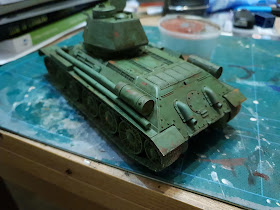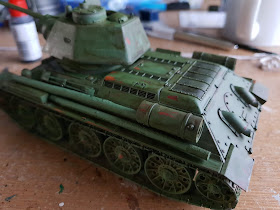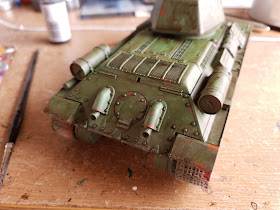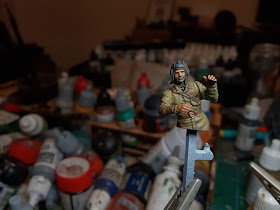The Soviet T-34 was the tank that won the war. With its revolutionary design and the ruthless industrial might of the USSR behind its construction, it helped halt wehrmacht advance and turn the tide of the war. After watching me building the submarine, the Eldest asked for a model of his own; when he asked for a tank, I knew there was only one to make him. Along the way - although I knew this would be a display model - I experimented with a few new techniques I intend to use on some wargaming miniatures.
Apologies but this going to a very detailed and pic-heavy post as I want to recrod step by step what I did for fufutre reference.
Step one, as always, was construction.
There were a few buts that needed filling.
Sealing the rubber tracks required a bit of medieval technology....
But we ended up with a final piece.
I painted the interior of the turret and breech - althought it seemed very unlikely you'd see in.
making the antenna used the same candle to stretch some sprue - this is the first time I'd ever done this; normally I'd use very thin brass rod.
Now onto the new techniques. I airbrushed the whole thing in rust tones (actually the same as Uruk Hai flesh but with orange patches.
Then I hit the whole thing with Chipping Fluid and let it dry for an hour.
Then I sprayed my base colour; given the historical variation in green paint used across just 1943 alone, I didn't feel too constrained.
Then I started chipping the base colour off, revealing the rust beneath.
Once happy with the overall look of the first layer of subractive weathering, it was timeto start adding. The first was a layer of grime - very, very thin smoky ink in this case.
Then detail painting of the stowage and metal chipping added with a brush and sponge on some hard corners.
The painting of the tank was now finished.
Then a thicker mix with binder creates a paste which becmes mud on the tracks, mudguards and undersides.
Finally a thin mix is gathered onto a flat brush and flicked on a cocktail stick; this creates mud splashes all over the sides, front and rear.
Now it was on to the loader, peering out of the hatch to direct the tank. This turned out to be phenomenally easy - 1/35 is significantly larger than 28mm.
A final daylight test to checkl the colours...
And on to the base. One tip I picked up from the Vallejo youtube tutorials was to use cheap picture frames on the bases - it's amazing how much more professional it makes the thing look. I roughed out the basic look...
Then libreally coated with polyfilla - making sure to create tracks for the tank.
At this point adjusted the mud on the wheels having now got a feel for what the ground will look like.
Aibrushed the base, making sure to change the colour of the disturbed mud where the tracks had churned it up.
Static grass added
And then cracked the old favourite leaf punch out.
And added some water effects in the deeper puddles.
It was then just a matter of gluing the tank down and blending in some more pigment mud paste.
The final piece:











































































































Ace job!!!
ReplyDeleteThat's incredible. In fact I had to check the first pic twice!!
ReplyDeleteMe, too, Suber! Had me fooled again. Excellent work, Mr. West!
ReplyDelete(funny thing, as I was reading this I was watching an episode of Columbo, in which he encounters a Russian cleaning woman who uses that phrase ("dasvidaniya", in her case followed by "police boy")
Great job, love the very detailed tutorial.
ReplyDeleteCheers,
JB